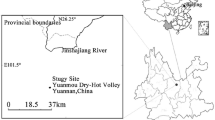Abstract
In order to explore the relationship between the time processes of solar radiation and sap flow, sap flow velocity (SFV) of Platycladus orientalis and Pinus tabulaeformis, effective solar radiation (ESR) and other environmental factors were synchronously monitored for one year in the Beijing Western Mountains by using a thermal dissipation probe (TDP) system and an automatic weather station. Results showed significant differences between changes in diurnal characteristics of ESR and sap flow in sunny days during three seasons. Starting times of sap flow occurred generally 1.5–3 hours later than those of solar radiation and there were small differences between Platycladus orientalis and Pinus tabulaeformis. But peak times and stopping times of sap flow varied considerably with large contrasts in ESR. The duration of sap flow showed clear differences among the seasons owing to the variable rhythms of climate factors in Beijing. Fluctuation amplitude in the duration of sap flow remained relatively stable during the autumn but changed greatly during spring and summer. Changes in diurnal sap flow velocity of both Platycladus orientalis and Pinus tabulaeformis were about 0–3 hours later than those of ESR but with the same configuration. The start of sap flow was mainly induced by the sudden intensification of ESR (sunrise effect). Seasonal models of SFV indicated that a cubic equation had the best fit. It was more practical to simulate seasonal water consumption models of trees with ESR. In further investigations, these models should be optimized.
Similar content being viewed by others
References
Chelcy R F, Carol E G, Robert J M, Rodney E W, Robert O T. 2004. Diurnal and seasonal variability in the radial distribution of sap flow: predicting total stem flow in Pinus taeda trees. Tree Physiol., 24: 941–950
Granier A. 1985. A new method of sap flow measurement in tree stems. Une nouvelleméthode pour la mesure du flux de sève brute dans le trone des arbres. Ann. For. Sci., 42: 193–200
Granier A. 1987. Evaluation of transpiration in a Douglas fir stand by means of sap flow measurements. Tree Physiol., 3: 309–320
Hinckley T M, Brooks J R, Cermak J. 1994. Water flux in a hybrid poplar stand. Tree Physiol., 14: 1,005–1,018
Khalil A A M, Grace J. 1992. Acclimation to drought in Acer pseudoplatanus L. (Sycamore) seedlings. J. Exp. Bot., 43(257): 1,591–1,602
Kolb K J, Sperry J S. 1999. Differences in drought adaptation between subspecies of sagabrush (Artemisia tridentata) Ecology, 80(7): 2,373–2,384
Linton M J, Sperry J S, Williams D G. 1998. Limits to water transport in Juniperus osteosperma and Pinus edulis: implications for drought tolerance and regulation of transpiration. Funct. Ecol., 12(6): 906–911.
Liu F J, Zheng S K. 1992. Research on Water Physiology of Populus. Beijing: Beijing Agricultural University Press (in Chinese)
Martin T A. 2000. Winter season tree sap flow and stand transpiration in an intensively-managed loblolly and slash pine plantation. J. Sustain. For., 10(1/2): 155–163
Mcllroy I C. 1984. Terminology and concepts in natural evaporation. Agric Water Manage., 8: 77–98
Milburn J A. 1996. Sap ascent in vascular plants: challengers to the cohesion theory ignore the significance of immature xylem and the recycling of muncha water. Ann. Bot. 78(4): 399–407
Pan R Z. 2001. Plant Physiology. Beijing: Higher Education Press (in Chinese)
Schneider H, Thurmer F, Zhu J J, Wistuba N, Gessner P, Lindner K, Herrmann B, Zimmermann G, Hartung W, Bentrup F W, Zimmerman U. 1999. Diurnal changes in xylem pressure of the hydrated resurrection plant Myrohamnus flabellifolia: evidence for lipid bodies in conducting xylem vessels. New Physiol., 143(3): 471–484
Si J H, Feng Q, Zhang X Y. 2004. Application of heat-pulse technique to determine the stem sap flow of Populus euphratica. J. Glaciol. Geocrylol., 26(4): 503–508
Sun H Z, Li Y P, Wang C, Zhou X F. 2005. Comparative study on stem sap flow of non- and ring-porous tree species. Chin. J. Ecol., 24(12): 1,434–1,439 (in Chinese with an English abstract)
Sun P S, Ma L Y. 2002. Research and Application on Water Consumption Characteristics of Water Conservation Tree Species. Beijing: Environmental Sciences Press (in Chinese)
Sun P S, Ma L Y, Wang X P, Zhai M P. 2000. Temporal and special variation of sap flow of Chinese pine (Pinus tabulaeformis). J. Beijing For. Univ., 22(5): 1–6 (in Chinese with an English abstract)
Zhang N N, Xu D P, Morris J, Zhou G Y, Zhou G Y, Wu Z M. 2003. Characteristics of sap flow in Eucalyptus urophylla plantations on the Leizhou Peninsula. For. Res., 16(6): 661–667 (in Chinese with an English abstract)
Zhao P, Rao X Q, Ma L, Cai X A, Zeng X P. 2006. Sap flow scaled stand transpiration and canopy stomatal conductance in an Acacia mangium forest. J. Plant Ecol., 30(4): 655–665 (in Chinese with an English abstract)
Zhao W F, Wang H T, Qi L Y, Zhang Y H. 2007. Spatial variation of sap flow of Quercus acutissima and its lag effect during spring. J. Plant Ecol., 31(2): 320–325 (in Chinese with an English abstract)
Zhou H Y. 1998. Effect of rainfall on the transpiration rate and internal factors of Populus cathayana. J. Arid Land Resour. Environ., 12(2): 62–66 (in Chinese with an English abstract)
Author information
Authors and Affiliations
Corresponding author
Rights and permissions
About this article
Cite this article
Xu, Jl., Ma, Ly. Relationship between effective solar radiation and sap flow process during an entire growing season in Western Mountains of Beijing. For. Stud. China 9, 251–255 (2007). https://doi.org/10.1007/s11632-007-0039-6
Received:
Accepted:
Issue Date:
DOI: https://doi.org/10.1007/s11632-007-0039-6



